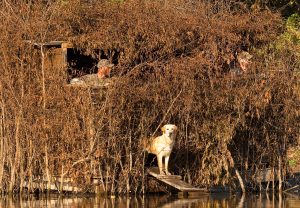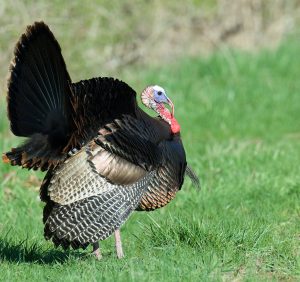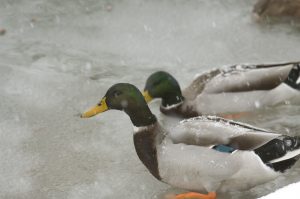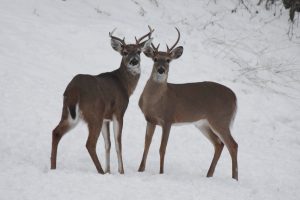Hunting for Conservation: Sportsmen Play Key Roll in Preserving Habitat
Hunters are among the most ardent conservationists. Theodore Roosevelt, the founder of the National Wildlife Refuge System and a hunter himself, acknowledged it. “In a civilized and cultivated country, wild animals only continue to exist at all when preserved by sportsmen,” the 26th president of the United States said years ago.

Dog in blind. Photo courtesy Tom Rollins, Thomas Rollins Photography
“Hunters are a driving force behind funding many of our nation’s conservation efforts,” a 2017 Interior Department blog said. “After the extinction of the passenger pigeon and the near elimination of the bison and many migratory bird species in the early 1900s, Americans realized the impacts humans could have on wildlife. To ensure that there would be animals to hunt in the future, hunters began to support programs that helped maintain species populations and protected habitat for wildlife.”
What does conservation mean?
Conservation is defined as the act of preserving, guarding and protecting. When talking about a single animal, hunting doesn’t fit the definition of conservation. However, when conservation refers to protecting and preserving biodiversity, the environment and natural resources, hunting reveals its true value.

Tom turkey. Photo courtesy Tom Rollins, Thomas Rollins Photography
The National Wild Turkey Federation was formed in 1973 to help restore wild turkeys. Thanks to the efforts of state and federal agencies, corporations, private landowners, and passionate NWTF volunteers and staff, wild turkey populations throughout North America have been restored from a historic low of about 200,000 to nearly 6.5 million birds today. An important part of maintaining healthy, sustainable and hunt-able wild turkey populations for generations to come is active habitat management, which includes the use of prescribed burning or prescribed fire.
While the loss of wild turkey nests to prescribed fire is a legitimate concern, a majority of wild turkey research shows very few turkey nests are lost directly because of springtime burns. Research suggests that hens prefer nesting in areas that have been burned within the past two years and not in high numbers in unburned areas because the habitat is too thick. For the few nests that are lost due to habitat management activity, predation, or even weather-related events, it’s important to note that hens may re-nest up to three times.

Mallard ducks. Photo courtesy Tom Rollins, Thomas Rollins Photography
Ducks Unlimited is the world’s leader in wetlands and waterfowl conservation. DU got its start in 1937 during the Dust Bowl when North America’s drought-plagued waterfowl populations had plunged to unprecedented lows. Determined not to sit idly by as the continent’s waterfowl dwindled beyond recovery, a small group of sportsmen joined together to form an organization that became known as Ducks Unlimited—its mission: habitat conservation. Thanks to decades of abiding by that single mission, Ducks Unlimited is now the world’s largest and most effective private waterfowl and wetlands conservation organization. DU is able to multilaterally deliver its work through a series of partnerships with private individuals, landowners, agencies, scientific communities and other entities. Restoring grasslands, replanting forests and restoring watersheds are among the ways DU practices habitat conservation.

Two bucks in snow. Photo courtesy Joann Fricke
The mission of Whitetails Unlimited is to raise funds in support of educational programs, wildlife habitat enhancement & acquisition and preservation of the hunting tradition for future generations. Founded in 1982, WTU is a national nonprofit conservation organization that has made great strides in the field of conservation–expending over $85.7 million on program services and support activities to foster their mission.
In 2011, the Illinois Department of Natural Resources (IDNR) implemented the Illinois Recreational Access Program (IRAP) by utilizing resources obtained from the U S Department of Agriculture’s Natural Resource Conservation Service (NRCS) Voluntary Public Access-Habitat Incentive Program (VPA-HIP). Working with private landowners, this program offers access to their land by hunters, anglers and others who enjoy the outdoors. In exchange, IDNR is using VPA-HIP grant funds to help these landowners to protect and restore their land. Landowners who choose to lease their property to IRAP will have a comprehensive habitat/forestry management plan written and be eligible for assistance to implement habitat restoration projects. Clifftop participates in the IRAP program at both White Rock Land and Water Reserve and the Paul Wightman Subterranean Nature Preserve (PWSNP), as does Baebler Educational Farm.
Practical support
Through the purchase of the Federal Migratory Bird Hunting and Conservation Stamp, more commonly known as the Duck Stamp, hunters help protect and restore habitat for migratory waterfowl and other birds and wildlife. The stamp is required as a license for waterfowl hunting. For every dollar spent on Duck Stamps, ninety-eight cents goes directly to purchase vital habitat or acquire conservation easements within the National Wildlife Refuge System. Since 1934, almost 6 million acres of habitat have been conserved with the help of Duck Stamp funds.
Through the Federal Aid in Wildlife Restoration Act, more commonly known as the Pittman-Robertson Act, hunters fund a range of conservation programs. The act sends revenue from an excise tax on firearms, ammunition and other related equipment to state wildlife agencies to be used for wildlife conservation projects, hunter education and outdoor recreation access. Through Pittman-Robertson, sportsmen and women have contributed more than $14 billion to conservation since 1937. These annual payments to state fish and wildlife agencies have resulted in the recovery of deer, turkey and many non-game species.
Since its inception, IRAP has written more than 70 habitat/forestry plans and conducted more than 11,000 acres of habitat projects on IRAP leased private property. This includes invasive species control with aerial spraying and on-the-ground removal, prescribed burning, grass and tree planting, pollinator establishment and more. The IRAP Strike Team has led prescribed burns at White Rock Land and Water Reserve on two separate occasions, providing burn plans, proper permits, a burn boss, experienced personnel and some burn equipment. Clifftop supplies volunteers with burn suits and additional personal protective equipment as well as tools to manage the fire. IRAP has also funded bush honeysuckle eradication at PWSNP.
CLIFFTOP, a local nonprofit organization, is focused on preserving and protecting area blufflands.
A version of this article appeared in the February 1, 2019 edition of the Monroe County Independent.
©2019 all content rights reserved Clifftop NFP
Comments are currently closed.
